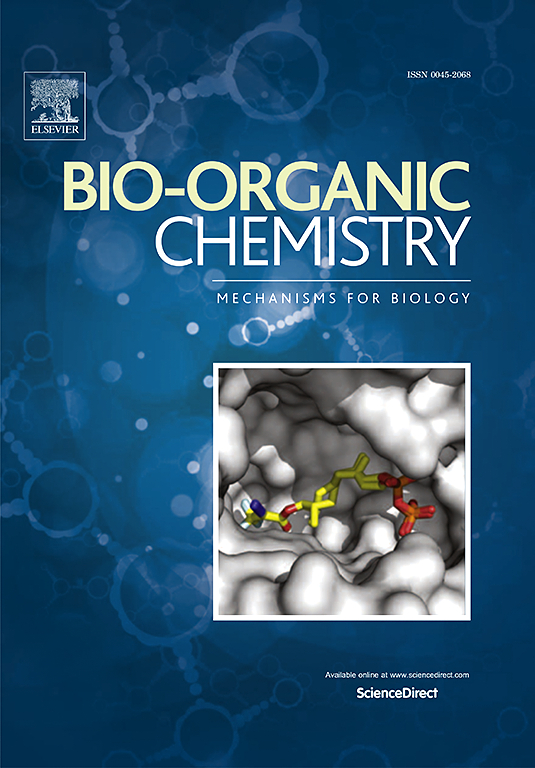Genome-guided discovery of coublibactins from Nocardia coubleae and their gallium complexes with potent antileukemic activity
IF 4.5
2区 医学
Q1 BIOCHEMISTRY & MOLECULAR BIOLOGY
引用次数: 0
Abstract
The pursuit of highly effective and selective anticancer drugs remains a critical challenge. Metal-based complexes, particularly gallium-containing compounds, offer promising therapeutic avenues due to their unique mechanisms of action. To identify novel scaffolds for such complexes, we performed a comprehensive genomic analysis of Nocardia species, revealing the prevalence of siderophore biosynthetic gene clusters, including the highly conserved nocobactin NA-like clusters. From N. coubleae DSM 44960, we isolated three new siderophores, coublibactins A–C (1–3), along with eight congeners (4–11) with known planar structures, all characterized by exceptional iron-binding affinity. Subsequent gallium substitution yielded gallium complexes (Ga-1–11). Among these, Ga-6 exhibited significant anticancer activity against human acute promyelocytic leukemia NB4 cells with IC50 value of 1.35 μM. Pharmacological studies showed that Ga-6 induces cell cycle arrest and apoptosis in NB4 cells. Our findings revealed microbial siderophores as promising scaffolds for the design of next-generation metal-based anticancer therapeutics, particularly gallium-based agents.

基因组引导下发现双联诺卡菌中的双联菌素及其具有有效抗白血病活性的镓复合物
追求高效和选择性的抗癌药物仍然是一个严峻的挑战。金属基配合物,特别是含镓化合物,由于其独特的作用机制,提供了有希望的治疗途径。为了找到这种复合物的新支架,我们对诺卡菌进行了全面的基因组分析,揭示了铁载体生物合成基因簇的流行,包括高度保守的诺科actin na样基因簇。从N. coubleae DSM 44960中,我们分离到了3个新的铁载体,coublibactins A-C(1-3),以及8个已知平面结构的同源物(4-11),它们都具有特殊的铁结合亲和力。随后镓取代生成镓配合物(Ga-1-11)。其中Ga-6对人急性早幼粒细胞白血病NB4细胞表现出显著的抗癌活性,IC50值为1.35 μM。药理研究表明,Ga-6可诱导NB4细胞周期阻滞和凋亡。我们的研究结果表明,微生物铁载体是设计下一代金属基抗癌药物,特别是镓基药物的有前途的支架。
本文章由计算机程序翻译,如有差异,请以英文原文为准。
求助全文
约1分钟内获得全文
求助全文
来源期刊

Bioorganic Chemistry
生物-生化与分子生物学
CiteScore
9.70
自引率
3.90%
发文量
679
审稿时长
31 days
期刊介绍:
Bioorganic Chemistry publishes research that addresses biological questions at the molecular level, using organic chemistry and principles of physical organic chemistry. The scope of the journal covers a range of topics at the organic chemistry-biology interface, including: enzyme catalysis, biotransformation and enzyme inhibition; nucleic acids chemistry; medicinal chemistry; natural product chemistry, natural product synthesis and natural product biosynthesis; antimicrobial agents; lipid and peptide chemistry; biophysical chemistry; biological probes; bio-orthogonal chemistry and biomimetic chemistry.
For manuscripts dealing with synthetic bioactive compounds, the Journal requires that the molecular target of the compounds described must be known, and must be demonstrated experimentally in the manuscript. For studies involving natural products, if the molecular target is unknown, some data beyond simple cell-based toxicity studies to provide insight into the mechanism of action is required. Studies supported by molecular docking are welcome, but must be supported by experimental data. The Journal does not consider manuscripts that are purely theoretical or computational in nature.
The Journal publishes regular articles, short communications and reviews. Reviews are normally invited by Editors or Editorial Board members. Authors of unsolicited reviews should first contact an Editor or Editorial Board member to determine whether the proposed article is within the scope of the Journal.
 求助内容:
求助内容: 应助结果提醒方式:
应助结果提醒方式:


